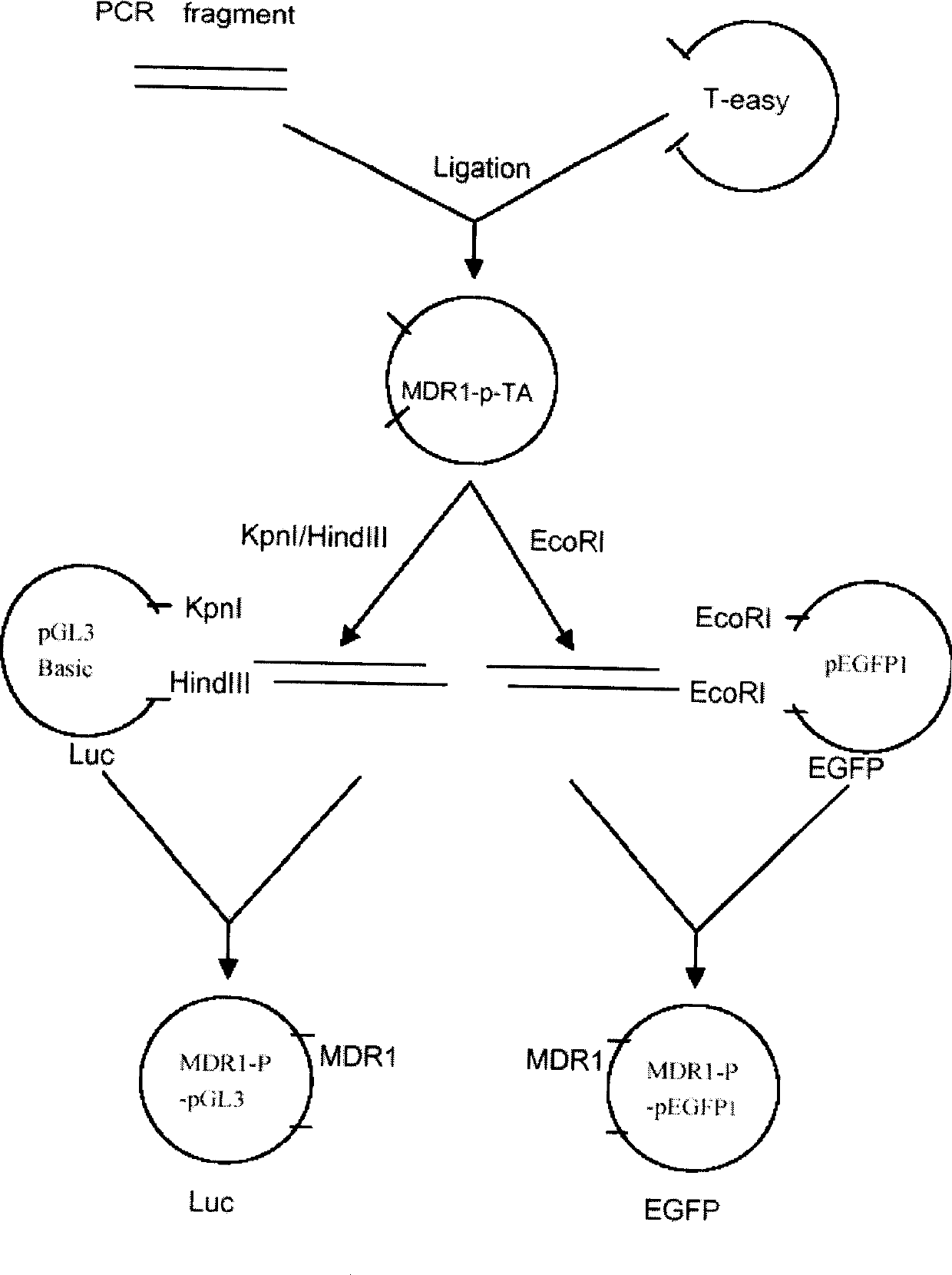Human MDR1 gene expression regulator screening system and method for screening gene expression regulator
A technology of gene expression and regulators, applied in genetic engineering, plant genetic improvement, botany equipment and methods, etc., can solve the problems of difficult application, high toxicity and side effects, etc., and achieve the effect of wide applicability and simple screening method
- Summary
- Abstract
- Description
- Claims
- Application Information
AI Technical Summary
Problems solved by technology
Method used
Image
Examples
Embodiment 1
[0042] Extraction of Human Genomic DNA
[0043] 1. Take 3ml of human peripheral blood, add anticoagulant, mix well
[0044] 2. Centrifuge at 3000rpm 4°C for 20'.
[0045] 3. Suck off the upper layer of plasma, be careful not to suck off the middle white blood cell layer.
[0046] 4. Add 5 times the volume of sterile double-distilled water, mix well, and place at room temperature for 5-10 minutes.
[0047] 5. Centrifuge at 4000 rpm for 20 minutes at 4°C and discard the supernatant. Be careful not to aspirate the leukocytes.
[0048] 6. Add 5ml of normal saline to restore the white blood cells to an isotonic environment.
[0049] 7. Centrifuge at 4000rpm for 15 minutes at 4°C and discard the supernatant.
[0050] 8. Repeat steps 6 and 7 twice for a total of 3 washes
[0051] 9. Obtain the buffy coat.
[0052] 10. Add 5ml digestion buffer (TES solution) to the white blood cells
[0053] (15mM Tris-cl, 15mM EDTA, 15mM Nacl, 0.5% SDS)
[0054] 11. Add proteinase K to a fin...
Embodiment 2
[0061] Fishing of the MDR1 promoter region
[0062] 1. Primer Design
[0063] Find the base sequence of the MDR1 promoter region from GenBank according to literature reports, and design primers for PCR amplification based on this sequence. The primer sequence is as follows: the upstream primer is: 5'-GGGGTACCCCAGTCTCTACG-3'; the downstream primer is: 5 '-CAAGCTTGTCCGACCTGAAGAG-3'. The 5' end has a Kpn I restriction site, and the 3' end has a HindIII restriction site.
[0064] 2. PCR amplification
[0065] Using human genomic DNA as a template, the primers synthesized above were used for PCR amplification. The PCR reaction conditions are: 94°C, 5min; 94°C, 1min, 62°C, 45sec, 72°C, 1min, 30 cycles; 72°C, 10min.
[0066] 3. Electrophoresis and recovery of PCR products
[0067] Perform electrophoresis on the above PCR product with 1% agarose gel. After electrophoresis, cut a small opening with a blade in front of the 2Kb band in the PCR product, insert DE81 filter paper, cont...
Embodiment 3
[0073] Construction of MDR1-p-pGL3 and MDR1-p-pEGFP1 recombinant plasmids
[0074] Amplify the above-mentioned TA clone bacteria and extract the plasmid, digest with Kpn I and HindIII, and recover a 2Kb fragment; at the same time, digest pGL3 with Kpn I and HindIII, recover the digested plasmid, and combine the recovered fragment with pGL3 The plasmid was ligated with TAKARA ligase I. When constructing the MDR1-p-pEGFP1 recombinant plasmid, the positive TA clone plasmid and the pEGFP1 vector were digested with EcoR I and the fragments were recovered for ligation. The ligation method was carried out according to the instructions of the TAKARA Ligation Kit. After ligation at 16°C for 4 hours, the ligation product was treated as above and electrotransformed into DH5α, the bacteria were spread on LB medium with ampicillin, and cultured overnight in a 37°C incubator. Pick the colony and inoculate it into 2ml of LB medium, culture it with shaking at 37°C overnight, extract the plasm...
PUM
 Login to View More
Login to View More Abstract
Description
Claims
Application Information
 Login to View More
Login to View More - R&D
- Intellectual Property
- Life Sciences
- Materials
- Tech Scout
- Unparalleled Data Quality
- Higher Quality Content
- 60% Fewer Hallucinations
Browse by: Latest US Patents, China's latest patents, Technical Efficacy Thesaurus, Application Domain, Technology Topic, Popular Technical Reports.
© 2025 PatSnap. All rights reserved.Legal|Privacy policy|Modern Slavery Act Transparency Statement|Sitemap|About US| Contact US: help@patsnap.com



